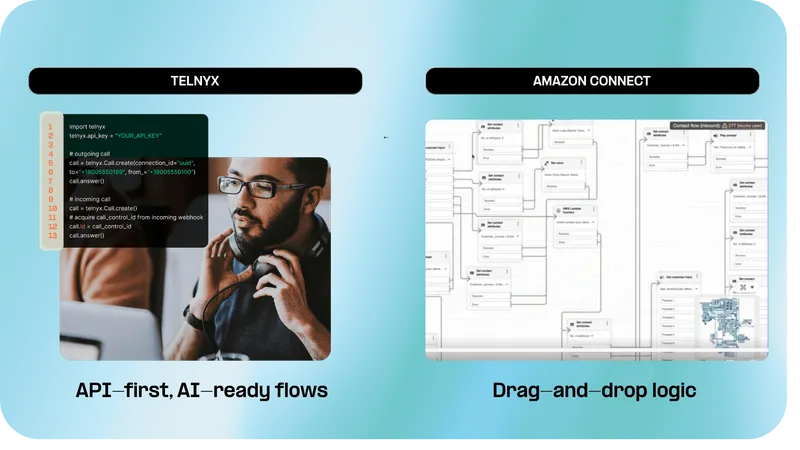PatientSyncmanages millions of critical healthcare calls every year. From late-night triage to billing support and appointment reminders, every call needs to be fast, responsive, and accurate. But when they tried to scale on Amazon Connect, they hit a wall.
Call flows built with drag-and-drop logic were hard to maintain. Number management slowed operations. AI agents were difficult to integrate without workarounds. And performance suffered when call traffic routed over the public internet.
So they moved to Telnyx.
By rebuilding their voice platform on Telnyx’s programmable platform, PatientSync unlocked a more reliable, scalable and flexible voice system that fits directly into their workflows. It runs on a private, low-latency network with built-in AI orchestration giving their team real-time control. Let’s look at why PatientSync made the switch and what other teams can learn.
From visual builders to flexible APIs
Amazon Connect is built for simplicity. It offers a turnkey, omnichannel contact center with a visual interface. But simplicity has a ceiling. As needs grow, like integrating AI agents, building smarter routing, or scaling globally, Connect’s model becomes more complex to maintain.
PatientSync had reached that ceiling on Amazon Connect. They needed flexibility, not more flowcharts. With Telnyx, they started using event-driven call control APIs to shape and update their flows in real time. Instead of modifying a flowchart, developers write logic that adapts instantly to each caller’s context based on data from internal systems, previous interactions, or live voice input. It’s easier to scale, easier to debug, and much faster to iterate.

“Telnyx gives us the flexibility and performance to build AI-powered call flows that feel natural, responsive, and always available,” said Clint Holliday, CTO at PatientSync.
Real‑time control for every interaction
With Telnyx, PatientSync has fine-grained control over every call leg, from initiation to transcription and routing. Their backend listens for live webhook events, like call initiation, DTMF input, bridging, and hangups and reacts immediately.
With Telnyx, you can:
Dynamically enqueue and route with your own logic:Create your own version of a skill‑based routing profile, control hours of operation in code, and decide which queue gets a call, replacing Amazon Connect routing profiles and queue groups.
Build custom, event‑driven IVRs with state management: Go beyond static menus. Maintain sophisticated call state across steps, retries, transfers, and callbacks.
Route calls on multiple inputs:Make real‑time decisions using DTMF and speech (including partial results) to steer callers without adding flowchart complexity.
Record and transcribe with speaker diarization:Enable call recording and use the built‑in transcription engine with speaker diarization to identify who’s speaking on a live call for better QA, coaching, and analytics.
Escalate to humans instantly:Hand off complex calls to agents running the Telnyx WebRTC client in a web, or via mobile SDKs, while preserving context and continuity. Telnyx supports WebRTC and SIP side‑by‑side, so everything works inside a modern, browser‑based agent desktop that you can design.
Log and act on data from the first ring:Write to your systems of record the moment a call starts, trigger recordings only when needed, and automate next steps based on outcomes.
Why this works
Event‑driven call control replaces sprawling visual flows with compact, testable code. That means faster iterations, easier debugging, and the freedom to evolve your experience without rebuilding labyrinthine diagrams. With Telnyx, PatientSync can keep shipping improvements without hitting the ceiling of a visual builder.
Low-latency calls on a private global network

Amazon Connect routes voice over the public internet and relies on third-party carriers for PSTN access. That creates unpredictable latency, especially for global callers. Telnyx doesn’t take that risk.
Telnyx runs on a private global IP backbone with colocated GPUs for real-time voice processing. The result is ultra-low latency and near-instant responses, even for complex Voice AI use cases.That responsiveness is critical in healthcare, where delay can mean a dropped call, a missed reminder, or a frustrated patient.
Simple, scalable number management
PatientSync serves customers across the country and needed a solution that could scale globally without friction.
With Telnyx, they can:
- Search, buy, and configure numbers via API
- Assign numbers dynamically
- Update voice settings instantly
- Manage global coverage with local numbers in 140+ countries
On Amazon Connect, number changes often require removing numbers from inventory mid-use, then re-adding them. That slows teams down and increases risk.
Built for scalable AI
One of the most important shifts was in how PatientSync could integrate voice AI Agents. Telnyx’s programmable platform lets them embed AI agents directly into their call flows using simple APIs.
With Telnyx, they can:
- Build AI Agents using their preferred LLM
- Combine them with real-time speech-to-text and text-to-speech
- Support conversations in multiple languages
- Store prompts, transcripts, and recordings securely in Telnyx Cloud Storage
Their assistants now:
- Handle inbound triage calls automatically
- Route based on patient history or spoken input
- Log every step to their CRM for continuity
- Scale instantly during peak hours
And if a case needs a human handoff, agents can see the full call history, including IVR selections, transcriptions, and wait time. This end-to-end visibility helps PatientSync deliver more personalized support, reduce handle times, and meet growing demand without increasing headcount.
Predictable pricing for healthcare growth
Telnyx Voice AI is priced per minute with no surprises. Compared to Amazon Connect’s usage-based billing and layered pricing model, Telnyx gave PatientSync a simpler, more predictable way to scale usage without losing control of costs.
This made it easier to justify automation use cases and to roll out AI agents that actually delivered ROI.
“Healthcare organizations need infrastructure they can trust for mission-critical conversations,” said Ian Reither, COO at Telnyx.
“Our private backbone and embedded AI orchestration allow innovators like PatientSync to deliver real-time, human-like voice AI at a fraction of the cost.”
What other teams can learn
PatientSync didn’t just change platforms. They changed their entire approach to voice. With Telnyx, they’ve built a contact center that adapts to their workflows, not the other way around. They control every aspect of the experience and can roll out new flows or features in hours, not weeks.
If your team is stuck maintaining brittle flows or dealing with fragmented infrastructure, it may be time to look at a more programmable solution.
By leaving behind rigid CCaaS tools like Amazon Connect and building with Telnyx, they now deliver voice experiences that are smart, scalable, and ready for healthcare’s next challenge. If your team is running into the limits of your current voice provider, it may be time to ask: What could we build if our call flows weren’t holding us back?
Want to see what this looks like in your industry?
Talk to us
and explore how programmable voice and AI can improve CX while lowering overhead and cost.
Learn more why Telnyx is a smarter choice
.
Share on Social
Sign up for emails of our latest articles and news
Related articles
